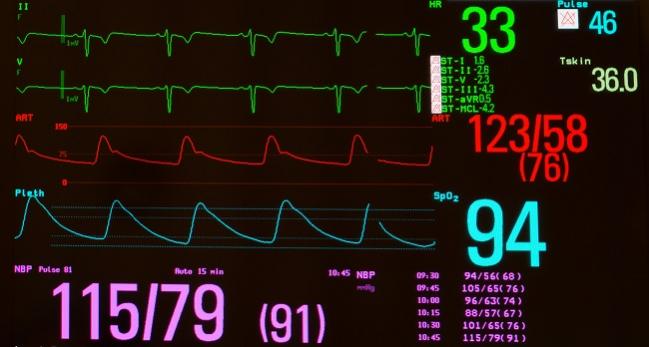Bradycardia Guidelines Offer Tips on Diagnosis, Management
The first multisociety document expressly created for bradycardia also includes advice on shared decision-making and end-of-life concerns.

The American College of Cardiology, the American Heart Association, and the Heart Rhythm Society have joined forces to develop a new guideline dedicated to the evaluation and treatment of bradycardia and cardiac conduction delay.
Fred M. Kusumoto, MD (Mayo Clinic, Rochester, MN), who chaired the document’s writing committee, told TCTMD it is the first of its kind to be expressly created for bradycardia. Prior iterations, including a 2008 guideline and a 2012 focused update from the same three professional societies, provide guidance on device-based therapy for cardiac rhythm abnormalities, he explained.
With the latest versions—a 2017 guideline on management of ventricular arrhythmias and prevention of sudden cardiac death as well as the current report—there was “an effort to get away from technology and rather focus on patient issues and patient problems,” according to Kusumoto. The bradycardia recommendations were published online November 6, 2018, in the Journal of the American College of Cardiology, Circulation, Journal of the American Heart Association, and HeartRhythm.
Evaluation and Treatment
The comparatively narrow focus of the new document allows it to more thoroughly explore “the diagnostic evaluation of patients either with overt bradycardia or with symptoms that are concerning for bradycardia and also for, let’s say, new left bundle branch block or other sorts of conduction disorders,” Kusumoto said. It includes information on the choice and timing of diagnostic tools such as monitoring devices, imaging, and ECG testing.
“We also talk about the acute management of bradycardia,” Kusumoto noted. “This is directed towards physicians who are taking care of these patients urgently, whether it be cardiologists, internists, or emergency room physicians, or even perhaps anesthesiologists who have the patient suddenly [develop] bradycardia.” Details are provided on lifestyle interventions, medical therapy, and pacing devices, and there is discussion about when to consider a permanent pacemaker in patients who’ve undergone transcatheter aortic valve replacement.
Including the patient and their family in all discussions about whether to implant the device or whether to withdraw therapy is really critical. Fred M. Kusumoto
The advice on pacemaker therapy in patients with bradycardia is largely similar to what came before, Kusumoto said. But the 2008 and 2012 versions set the threshold for needing a permanent pacemaker at pause durations of 3 seconds or greater. Now, there isn’t that limit. “In sinus node dysfunction, there is no established minimum heart rate or pause duration where permanent pacing is recommended,” as the document explains. “Establishing temporal correlation between symptoms and bradycardia is important when determining whether permanent pacing is needed.”
Also new is advice on what to do with patients who have an LVEF that isn’t low enough to qualify as heart failure, or what Kusumoto explained as “not normal but not quite as abnormal.”
“In patients with a left ventricular ejection fraction between 36% to 50% and atrioventricular block, who have an indication for permanent pacing and are expected to require ventricular pacing > 40% of the time, techniques that provide more physiologic ventricular activation (eg, cardiac resynchronization therapy, His bundle pacing) are preferred to right ventricular pacing to prevent heart failure,” the guideline explains.
The recommendation is based on a systematic review of eight studies involving a total of 679 patients, also published online in JACC. In it, a committee led by David Slotwiner, MD (NewYork-Presbyterian Queens and Weill Cornell Medical College, New York, NY), found that in patients with LVEF > 35%, biventricular pacing and His bundle pacing were linked to preserved or increased LVEF compared with right ventricular pacing. However, the review also suggested that when it comes to gains in patient-centered clinical outcomes, the benefit is “limited primarily to patients who have chronic atrial fibrillation with rapid ventricular response rates and have undergone atrioventricular node ablation.”
Other key ingredients are an emphasis on shared decision-making and end-of-life concerns, Kusumoto told TCTMD. “We’re the first guideline [in this area] that talks about the fact that you can remove or withdraw pacemaker therapy and that that would not be considered assisted suicide. . . . Including the patient and their family in all discussions about whether to implant the device or whether to withdraw therapy is really critical, because unfortunately we doctors have not been that good about that in the past.”
Caitlin E. Cox is News Editor of TCTMD and Associate Director, Editorial Content at the Cardiovascular Research Foundation. She produces the…
Read Full BioSources
Kusumoto FM, Schoenfeld MH, Barrett C, et al. 2018 ACC/AHA/HRS guideline on the evaluation and management of patients with bradycardia and cardiac conduction delay. J Am Coll Cardiol. 2018;Epub ahead of print.
Slotwiner DJ, Raitt MH, Del-Carpio Munoz F, et al. Impact of physiologic pacing versus right ventricular pacing among patients with left ventricular ejection fraction greater than 35%: a systematic review for the 2018 ACC/AHA/HRS guideline on the evaluation and management of patients with bradycardia and cardiac conduction delay. J Am Coll Cardiol. 2018;Epub ahead of print.
Disclosures
- Kusumoto and Slotwiner report no relevant conflicts of interest


Comments